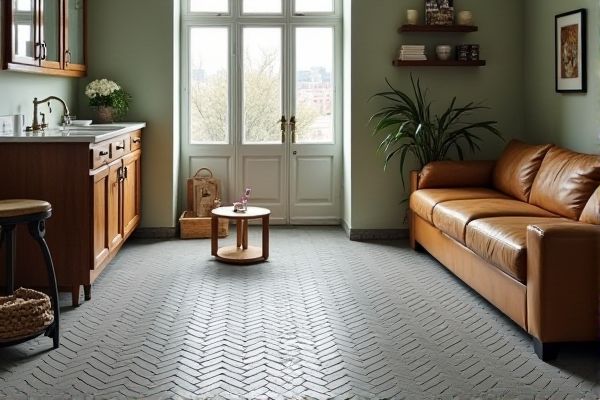
Rubber tiles provide superior cushioning and durability, making them ideal for high-impact areas, while interlocking plastic tiles offer easier installation and lighter weight suitable for versatile indoor and outdoor uses. Explore the article to discover which option fits your specific needs and how to make the best choice for your space.
Table of Comparison
| Feature | Rubber Tiles | Interlocking Plastic Tiles |
|---|---|---|
| Material | Natural or synthetic rubber | Durable plastic polymers (e.g., polypropylene) |
| Durability | High resistance to wear and impact | Good resistance but less impact absorption |
| Installation | Loose lay or adhesive | Interlocking mechanism, easy DIY installation |
| Safety | Excellent shock absorption, slip-resistant | Moderate shock absorption, slip-resistant |
| Maintenance | Easy to clean, resistant to mold and mildew | Simple cleaning, may trap debris in seams |
| Weather Resistance | UV and weather-resistant | UV-resistant but can fade over time |
| Cost | Higher initial cost | Generally lower cost |
| Applications | Playgrounds, gyms, outdoor patios | Garages, workshops, sports courts |
| Lifespan | 10-20 years with proper care | 5-10 years depending on exposure |
Introduction to Rubber Tiles and Interlocking Plastic Tiles
Rubber tiles offer exceptional durability, shock absorption, and slip resistance, making them ideal for playgrounds and gyms. Interlocking plastic tiles provide easy installation, water drainage, and versatility suitable for patios and garages. Your choice depends on the specific application, required comfort, and maintenance preferences.
Material Composition and Durability
Rubber tiles are typically made from recycled rubber or synthetic rubber compounds, offering exceptional durability, shock absorption, and resistance to weathering and heavy foot traffic. Interlocking plastic tiles consist of polypropylene or polyethylene, providing a lightweight and water-resistant surface that resists fading but can be prone to cracking under extreme temperatures or heavy loads. Your choice depends on whether you prioritize the elasticity and longevity of rubber or the affordability and ease of installation found in interlocking plastic tiles.
Installation Process: Ease and Flexibility
Rubber tiles offer a straightforward installation process with adhesive or loose lay options, providing moderate flexibility for contours and uneven surfaces. Interlocking plastic tiles snap together effortlessly without adhesives, ensuring quick installation and easy removal or reconfiguration. The modular nature of interlocking plastic tiles allows greater adaptability for irregular spaces compared to rubber tiles.
Safety Features and Slip Resistance
Rubber tiles offer superior safety features due to their shock-absorbing properties, reducing the risk of injury from falls, making them ideal for playgrounds and gyms. Their high slip resistance remains effective even when wet, providing enhanced traction in various weather conditions. Interlocking plastic tiles typically have rigid surfaces that may become slippery when wet, offering less cushioning and posing a higher risk of slips and falls compared to rubber tiles.
Comfort and Shock Absorption Comparison
Rubber tiles provide superior comfort and shock absorption due to their dense, elastic composition that effectively reduces impact forces, making them ideal for playgrounds and gyms. Interlocking plastic tiles offer moderate cushioning but generally lack the same level of resilience, often resulting in a harder surface that transmits more impact to joints. The enhanced shock absorption of rubber tiles significantly minimizes fatigue and injury risk in high-activity areas compared to plastic alternatives.
Maintenance and Cleaning Requirements
Rubber tiles require minimal maintenance, only needing occasional sweeping and mild soap cleaning to prevent dirt buildup and preserve their durability. Interlocking plastic tiles demand more frequent cleaning since dust and debris can accumulate in the seams, often requiring pressure washing to maintain their appearance. Your choice depends on how much time and effort you can allocate for upkeep, as rubber offers easier long-term maintenance compared to plastic counterparts.
Aesthetic Options and Customization
Rubber tiles offer a wide range of colors, textures, and thicknesses allowing for tailored aesthetic designs ideal for playgrounds, gyms, and outdoor spaces. Interlocking plastic tiles provide versatility with varied surface patterns and easy-to-connect pieces, enabling quick customization and layout changes to fit your design preferences. Both materials enhance visual appeal but differ in tactile feel and long-term color retention under UV exposure.
Cost Analysis and Budget Considerations
Rubber tiles typically have a higher upfront cost than interlocking plastic tiles due to their durability and shock-absorbing properties, making them a long-term investment for playgrounds and gyms. Interlocking plastic tiles offer a budget-friendly alternative with lower initial expenses and easier installation but may require more frequent replacements or repairs over time. Evaluating lifecycle costs and maintenance requirements is essential for budget planning and determining the best flooring option based on project scope and usage intensity.
Ideal Applications for Each Tile Type
Rubber tiles are ideal for high-impact areas such as playgrounds, gyms, and sports facilities due to their superior shock absorption and durability. Interlocking plastic tiles suit environments requiring quick installation and easy maintenance, such as patios, garages, or event flooring. Choosing the right tile depends on Your specific needs, balancing comfort, resilience, and ease of upkeep.
Environmental Impact and Sustainability
Rubber tiles, often made from recycled materials such as tires, offer a sustainable option by repurposing waste and reducing landfill impact, while their durability minimizes replacement frequency. Interlocking plastic tiles, typically derived from virgin or recycled plastics, may contribute to microplastic pollution and rely on petroleum-based resources, impacting their overall environmental footprint. Choosing rubber tiles can enhance Your project's sustainability by leveraging eco-friendly materials and promoting circular economy principles.
 homyna.com
homyna.com